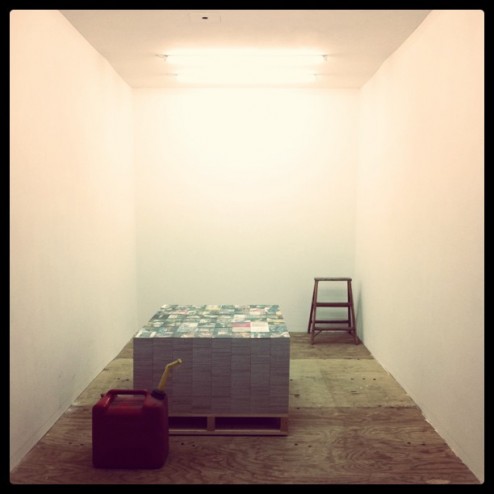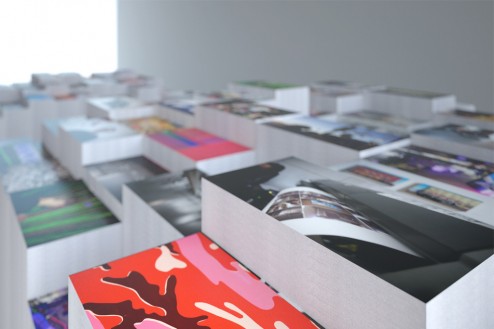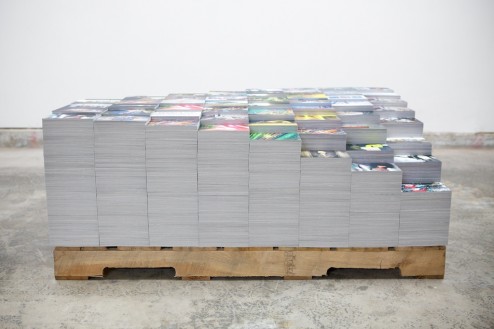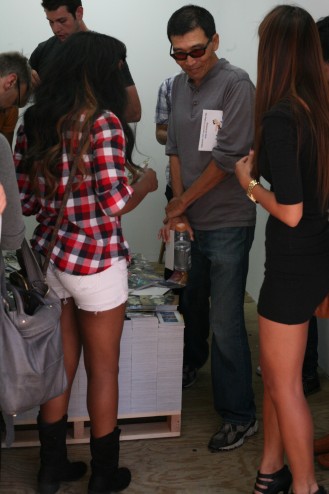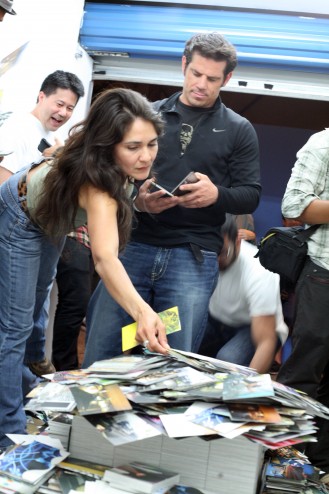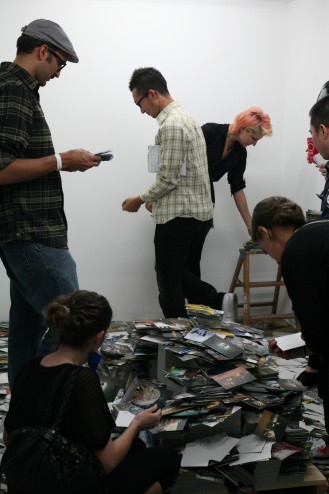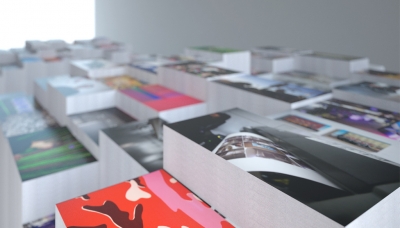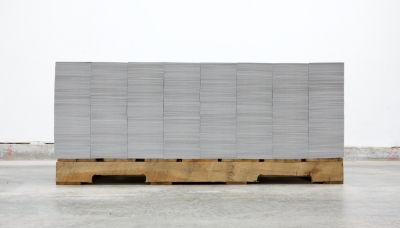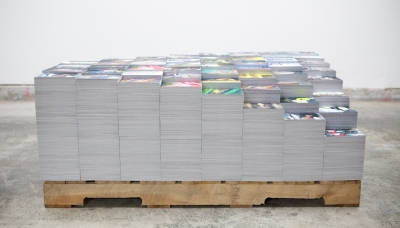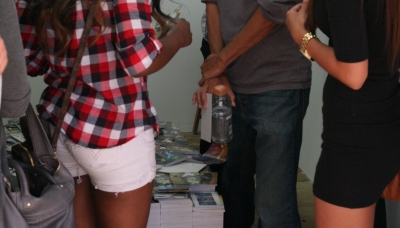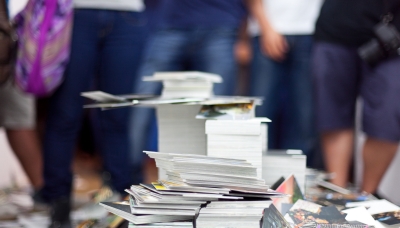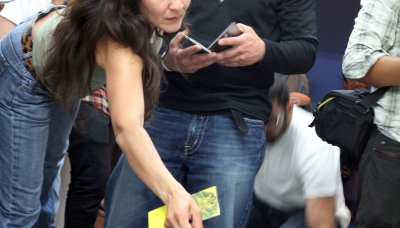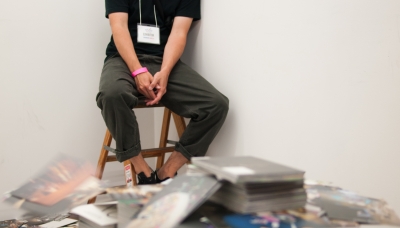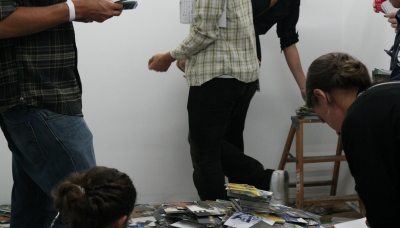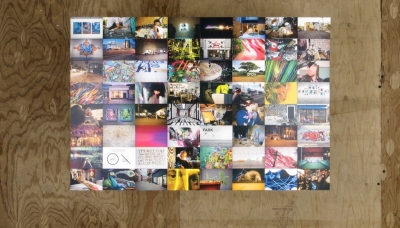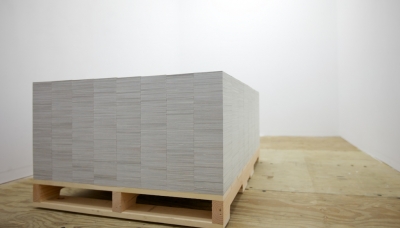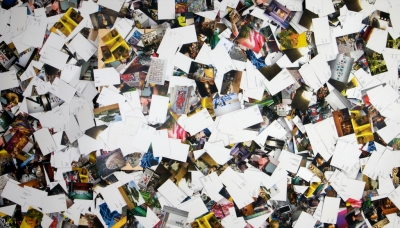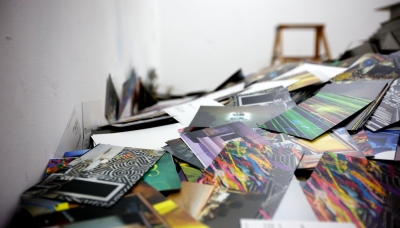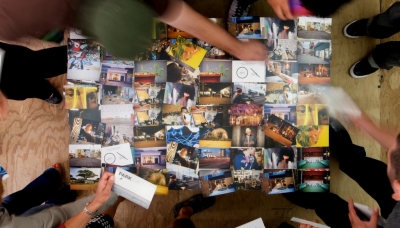ARTCUBE contains a novel interactive sculpture comprising photographs of the artistic processes and techniques captured by Brandon Shigeta in numerous visits to artist studios. Stacked into random arrays forming a single cubic massing the sculpture includes hidden signed cards and custom artwork on the surface of the postcards by artists. Perhaps qualifying the exhibit as the heaviest photographic exhibit ever, the sculpture consists of approximately 65,000 postcards of approximately 80 various images to be removed by visitors as souvenirs. The sculpture provides visitors with participatory spatial and tactile experiences in which they remove their favorite images to change the overall form of the mass to reveal new images below. A ceiling mounted camera will record a time-lapse image stream of the changing topography of the top of the sculptural surface over the course of the show.
ARTCUBE is a concentrated agglomeration of images that form narratives of artistic processes, assemblages and details like brush strokes. Those images also reveal their specific, sometimes even illegal, locations in city space and time. Ephemeral at their origin these artistic acts will be further dissolved by ARTCUBE‘s visitors into a flow of the fast paced and energetic cycles of aesthetic metropolitan consumption and production. They will become postcards from the present to a wonderfully fictional future city.
Brandon Shigeta is a Los Angeles based designer and design photographer. On completing his graduate studies in architecture at Harvard University Graduate School of Design Brandon won the prestigious Rotch Travelling Scholarship, which allowed him to visit many countries throughout Asia to document temporary metropolitan phenomena. His photographs were soon picked up by renowned fashion blog HYPEBEAST. Having worked in cutting edge design offices in Atlanta, Seoul and Tokyo Brandon brings a vibrant contemporary sensibility to his graphic design and photography. The art blog Arrested Motion regularly features his singular travel imagery and event coverage You may see numerous examples of Brandon’s work on his travel blog http://brandonshigeta.com/blog/.
Be sure to check out his beautiful and chaotic mess at Container 01, right across from the MOCA. Before the launch of his container exhibit, The Superslice caught up with rising star designer/photographer, Brandon Shigeta, and asked him a couple of questions about the current status of the art scene in Los Angeles, architecture and the exhibit itself.
ARTCUBE: Brandon Shigeta Interview
Tony Trinh: You studied architecture and earned your degree at Harvard GSD. How do the disciplines of architecture/design and photography inform and influence each other within your work?
Brandon Shigeta: I think in two aspects. I’m trained more as an architectural photographer, I shoot through that perspective. So proportions, everything is lens-corrected. The things I’m interested in like assemblage, details, I think, that rigidness, is all from my architectural training, but at the same time, I’d say that there’s a looseness in photography that I can explore, as opposed to not having that freedom within architecture.
TT: So photography is an outlet outside the strict discipline of architecture? You have parameters in design that you don’t have in photography.
BS: The speed and freedom of photography, especially in the realization of projects. Projects in architecture take years to accomplish. You have codes, regulations and clients. In photography, I can just do whatever I want and shoot whatever I want and I’m not bound by any formal training so I don’t think there are any rules to unlearn or break. I kind of just do whatever I want, where I don’t (have to) think. I have that freedom in (photography, as opposed to) architecture where it’s super rigid. Or at least, my style is. A lot of times I don’t even look at what I shoot, I just throw a camera around.
TT: Just do a free shoot.
BS: Exactly. In fact I look for the unexpected in photography sometimes. (It is) as unplanned as possible. Random shots!
TT: You’d say it’s more intuitive? So about intuition, it leads me to my next question about dealing with art. You’re embedded in the Los Angeles art scene, a scene that is growing and getting stronger every day. It’s pretty solid. How’s the status of the art culture in Los Angeles, in your opinion, currently?
BS: I think it’s a fairly exciting time right now for art in L.A. especially the kind of art that I’m into, the more street contextual-based art.
TT: Underground art?
BS: Exactly. Art that deals with the urban context (that) somehow influences architecture. We had the MOCA Art in the Streets show, and due to the overlap of that show, a lot of these artists are having sideshows. I associate with that kind of art scene, the lowbrow, the street art, the pop surrealism. Like the Culver City art galleries. Outside of that, I’m not too knowledgeable about the art scene in L.A.
TT: Like the fine art stuff?
BS: Like the fine art stuff. I mean, one of my favorite artists is Tara Donovan, but in terms of what goes on…there’s just a lot of street art going on and that’s what I’m visiting. Either it’s an assignment or it’s what I’m into.
TT: You’ve photographed the works of James Jean, Ryan McGuiness, Shepard Fairey, Dalek, Murakami, Chinese artist, Ai Weiwei. You’re the go-to guy for Hypebeast and Arrested Motion. What artists are currently on your radar? Who should we be looking out for?
BS: I’ve just recently been shooting art in the last eight months, a lot of this is actually new to me even though they might’ve been established earlier than when I started photographing some of these artists. One artist that I shot that kind of blew up afterwards was Hiroshi. It’s the skateboard artist from Japan that makes sculptures out of used skateboard decks. He takes recycled skateboards, stacks them like plywood and then he sculpts them from a block of stacked skateboards, so you get this texture of rainbow layers of plywood. From there he’ll sculpt hands, he’s done a Mario. It’s stuff related to skateboard culture.
TT: You won the Rotch Traveling Scholarship in 2009. Tell me about your traveling experiences. What was the highlight of that time for you? (It was a) cool entry, by the way. I took a look at your project. You were dealing with that brutalist ice factory.
BS: (laughs) I wasn’t sure how that was going to go. I just went with the super minimal side. Luckily it worked.
TT: People responded to that kind of, clear, type of intervention. You were dealing with different scales of perforation, right? It was kind of genius introducing this…you maintained the essence of the building.
BS: Exactly. I think that the problem was…I think I was the only one that kept the monolithic, iconic form. And the idea of piercing little punctures is that you wouldn’t read it from the outside except at night and you’d read it from the day inside. So that went pretty well and I basically went around Asia studying temporary phenomena in the urban context. So in Tokyo, a lot of pop-up stores, public exhibitions and that’s how I got into shooting art. A lot of the pop-up functions were art related and that’s when I got picked up by Hypebeast and in the end that’s how it turned out, so all of this has developed in the last eight months or so. A lot of the temporary phenomena I was studying was temporary architecture so it was everything from grass village huts in Malaysia to temporary pop-up stores in Tokyo.
TT: And that kind of fell in line with the first phase of the competition. The first phase of Rotch, you had to come up with some kind of pop-up bookstore?
BS: Oh, exactly, yes. The first phase was a pop-up bookstore, and the idea was that we had to create a shop that was used for other purposes and that was supposed to play into the secondary part of my research which I never got to, which was to create temporary phenomena in a city like Tokyo. Almost like an architectural graffiti or spatial graffiti, but setting up a series of structures, but none of that ever happened though.
TT: That’s an interesting concept.
BS: I guess I always try to relate everything that I do spatially back to architecture and creating this exhibition was a task of how to create a spatial interactive experience from something that’s planar, from the context that’s usually a photo on a wall. So making a mass out of something planar or as a tiny unit and being super wasteful and creating something.
TT: Let’s talk about that. For Little Tokyo Design Week you’re doing an exhibition titled ARTCUBE. It’s somewhat reminiscent of the beer pyramid installation at the KW Institute for Contemporary Art by French artist Cyprien Gaillard. I don’t know if you’ve heard about this installation. This is where the guy built a pyramid out of 72,000 bottles of beer and invited observers to drink up. His piece was about consumption, monumentality and destruction. You’re piece is not quite as bombastic, but you’re sculpture includes 65,000 cards of 80 different images?
BS: Yes.
TT: These images are meant to be taken by the festival-goers. This is sculpture that will evolve over time. The ideas you touch upon will include the aspect of temporality, this idea of image, ephemera. You’re also saying something about the process of collection and memory. Can you talk about how you came up with the idea for this installation and maybe elaborate upon those themes I mentioned?
BS: Originally I was presented an exhibition at LTDW as a simple slideshow. Images I have taken over the last couple of years including the images of the Rotch art coverage. Just to kind of give an overview of the contemporary art scene now and even on a global scale. I visited the Tokyo Art Fair, a lot of art in Bangkok, Hong Kong, so kind of all over Asia and L.A. I guess (I was) trying to explore (it) through an architectural aspect because I felt that the images…photography, first and foremost, is a hobby for me so that I didn’t think the images alone were all that special or all that great, and especially since each of the images had to get released by the artists and/or the gallery, so it was more about creating a group of photos or a collective that would speak of a narrative of the current art scene and something that might not be shown in art galleries. I thought it would’ve been kind of silly to show “photos of photos” or “photos of art” when there is so much art going on in L.A. I would suggest just walking across the street, or in this case, the courtyard, to MOCA and see the Art in the Streets in person.
TT: You’re representing the culture. You’re taking these pieces, these images and giving them physical form, by stacking them.
BS: Not only does it speak about the narrative of art, collectively, so that these images aren’t necessarily judged individually as the best photos ever, but that they exist as a collective, not only in the imagery, but in content, but in the mass itself.
TT: A collective culture.
BS: Exactly. Originally, it was a system that was based on primarily on budget and the space that was given, so with the provided budget I was able to print 65,000 cards. I pretty much blew the entire budget on printing. And from there, 65,000 cards became a mass that would fit into a container space. The concept was to be able to scale to any size. At one point, I had a rendering of a podium platform that people could walk on. You know, a space that would disintegrate or dissolve as you took cards off. From a much bigger scale, I guess. So this is a portion of what that is and that represents the budget and the space within those parameters this is the sculpture that resulted.
TT: You’re also doing a time-lapse documentation of this?
BS: All the images are stacked randomly…so it’s kind of a low-tech manual slideshow where instead of cards flipping on their own on a projected screen, people will come by and pick up cards off the mass or off the surface and it will reveal new pictures or artwork. I have a few embellished cards that are going into the stack. So there will be hidden embellished cards with signatures.
TT: Easter eggs!
BS: Exactly, yeah.
TT: What contemporary architects do you follow? Who’s doing interesting work in your eyes right now, architecture-wise?
BS: The two young architects I’m looking at now and the architects that are interesting to me are Junya Ishigami and Sou Fujimoto. They’re here at the symposium for LTDW. Sou will be participating in some fashion, I’m not sure how.

